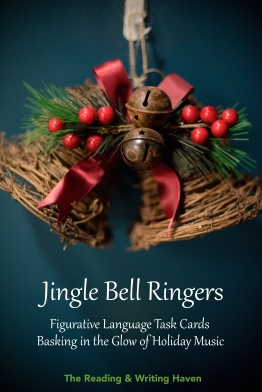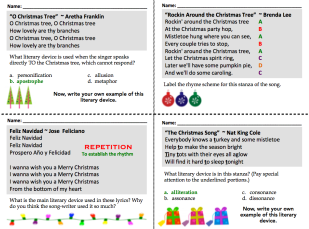“The best way to spread Christmas cheer is singing loud for all to hear.” One of the many lessons we learn from Buddy in the movie Elf is that singing is good for the soul. In this blog hop, I’m teaming up with a group of inspirational educators, and together, we are offering ideas for how we share some holiday cheer with our students.
While there are many different techniques I enjoy using to spread the excitement of Christmas (really, it’s infectious in the hallways, even at the high school level!), my favorite avenue is music. Music is just one of those things that can dig anyone out of a funk. It controls our mood and our energy levels. Just try to be cranky while you are singing an upbeat, positive song at the top of your lungs. It’s nearly impossible not to smile. Music is therapeutic. Like exercise. Or a massage. Or reading. Or writing. Or eating chocolate while drinking coffee (not that I would know anything about that).
Plus, research has proven time and time again that music is effective at bringing education to life. Just take a look at this study from Johns Hopkins School of Education for a glimpse of some of the amazing benefits of music. Here are a few:
“Music helps us learn because it will:
- establish a positive learning state
- create a desired atmosphere
- built a sense of anticipation
- energize learning activities
- change brain wave states
- focus concentration
- increase attention
- improve memory
- facilitate a multisensory learning experience
- release tension
- enhance imagination
- align groups
- develop rapport
- provide inspiration and motivation
- add an element of fun”
Give me some of all of that, please! Now that we’ve established that music “rocks,” so what? What does it have to do with the ELA curriculum? Well, I tie music into poetry and figurative language through bell ringers. This is an especially engaging exercise during the holiday season.
As we all know, the Common Core Standards require students to demonstrate an understanding of figurative language, to interpret figures of speech, and to analyze their roles in texts. Sometimes it might feel like a stretch to make a fun activity meet a standard, but music makes it simple and fun. I use these Jingle Bell Ringers during the month of December. Try this free sample.
What are Jingle Bell Ringers? They are task cards that focus on figurative language in classic and modern holiday songs. Each task card has an excerpt from a popular song, like “Jingle Bells,” “Feliz Navidad,” and “All I Want for Christmas.” Students are asked to focus on the excerpt provided and answer a question about figurative language in the music. I suggest using them as bell ringers because they only take a few minutes.
How do I use them? What I do is play the song at the beginning of class. Students listen and reap all the benefits of music as they complete that day’s bell-ringer task. Upon turning in their answers, I project the bell ringer up on the board, and we go over the answer together as a class so they have immediate feedback and a quick review.
How do I grade them? I love this part. Grading is easy. I give one point of extra credit to any student who answers correctly. A little bit of extra credit is another great way to spread some holiday cheer!
What’s the best part? Students like them! They enjoy guessing what the song will be for the next day, and they appreciate a chance to earn a point of extra credit right before final exams.
How do you spread holiday cheer with your students? Do you have ideas for how to use music and figurative language in the classroom? Don’t be a Scrooge…share your ideas in the comments section below!
“Music is the electrical soil in which the spirit lives, thinks, and invents.”
~ Ludwig van Beethoven ~
Click on the link below to see how some other amazing professionals share the holiday spirit with their crew!





The “Jingle Bell” ringers made me giggle. How fun!!
LikeLiked by 1 person
Extra credit for a fun holiday song is perfect. I love this idea!
LikeLiked by 1 person
Thx! ❤it!!
LikeLiked by 1 person
Music does “rock” in the classroom! I love your creative idea to incorporate it! Thanks!
LikeLiked by 1 person
I’ve got your figurative language task cards ready to go. I really like that they are multiple choice!
LikeLiked by 1 person